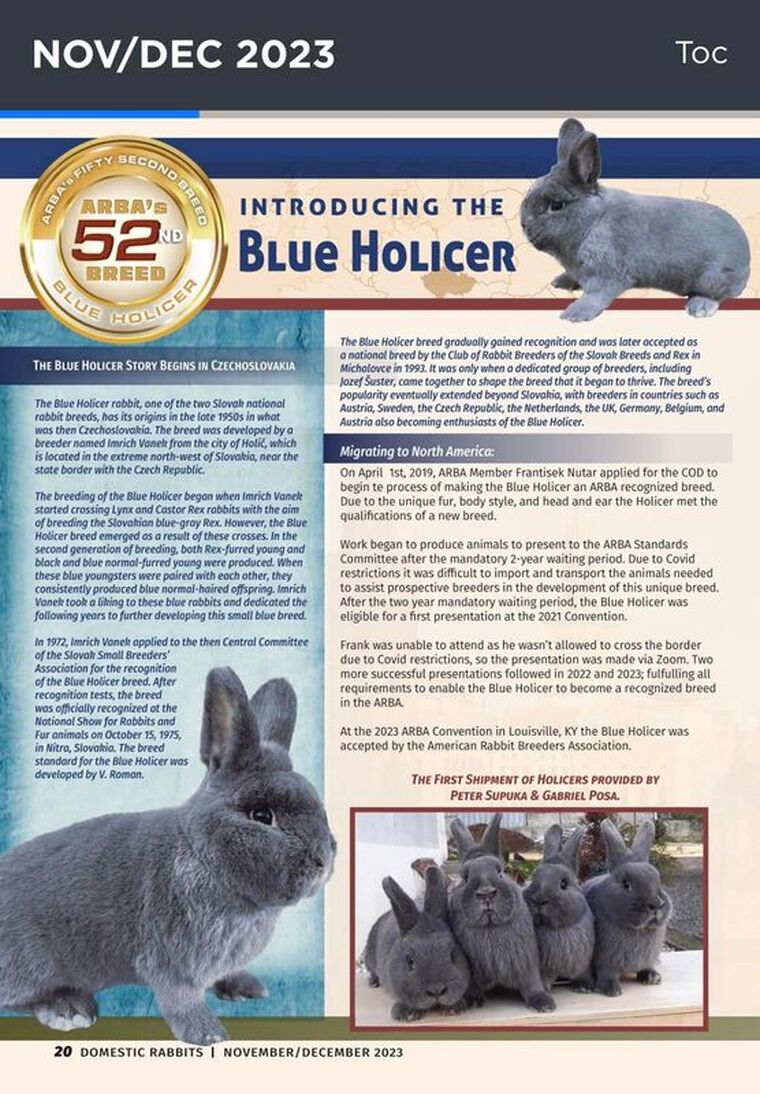Key Takeaways
-
The Blue Holicer rabbit is a rare breed, known for its unique light blue fur.
-
This breed was developed in the Czech Republic and recognized by the American Rabbit Breeders Association in 2023.
-
Blue Holicer rabbits are known for their friendly temperament and can make excellent pets for families.
-
They require specific care, including a balanced diet, regular grooming, and adequate space for exercise.
-
Adopting a Blue Holicer rabbit involves finding reputable breeders or rescue organizations that specialize in this rare breed.
What is a Blue Holicer Rabbit?
The Blue Holicer rabbit is a fascinating breed that stands out due to its unique light blue fur. This medium-sized rabbit has a stocky, upright cylindrical body and thickly furred ears, making it quite distinct from other rabbit breeds. The fur of a Blue Holicer is ultra-dense and medium steel blue, giving it a striking appearance.

“The Blue Holicer – A Rare Breeds Rabbit …” from www.barrowbunnies.com and used with no modifications.
Description and Characteristics
One of the most notable features of the Blue Holicer rabbit is its fur. Unlike other rabbit breeds, the Blue Holicer has a fur density and elasticity that is quite unique. This dense fur requires regular grooming to keep it in top condition. The light blue color of their fur, often described as “cloud blue,” sets them apart from other blue rabbit breeds, which typically have a darker hue.
Blue Holicer rabbits are medium-sized, typically weighing between 5 to 7 pounds. They have a compact body structure with a well-rounded head and short, upright ears. Their eyes are bright and alert, reflecting their friendly and curious nature.
-
Medium-sized, weighing 5-7 pounds
-
Stocky, cylindrical body
-
Short, upright ears
-
Dense, medium steel blue fur
-
Friendly and curious temperament
Origin and Breed History
The Blue Holicer rabbit has an interesting history that dates back to the 1950s in the Czech Republic. The breed was developed by Imrich Vanek, a dedicated breeder who aimed to create a rabbit with a unique light blue color. Initially, Vanek’s goal was to produce a small breed rabbit that was light blue in color, which he described as “cloud blue.”
“On 15 October 1975, at the National Exhibition of Rabbits and Fur Animals in Nitra, the Holičský modrý (Blue Holicer) became the 2nd Slovak National breed of rabbits.”
In 1972, the breed was officially recognized as the second national breed of rabbits in Slovakia under the name Holičský modrý, which translates to Blue Holicer. This recognition was a significant milestone for the breed, marking its importance in the rabbit breeding community.
Fast forward to October 2023, the Blue Holicer rabbit was accepted into the American Rabbit Breeders Association’s (ARBA) Standard of Perfection as the 52nd recognized breed of rabbit. This recognition was the result of a dedicated effort by breeders and enthusiasts who worked tirelessly to meet the ARBA’s stringent standards.
Are Blue Holicer Rabbits Rare?
Yes, Blue Holicer rabbits are considered a rare breed. Their unique characteristics and limited availability make them highly sought after by rabbit enthusiasts and pet owners alike.
Rarity in the Pet Market
In the pet market, Blue Holicer rabbits are not as commonly found as other rabbit breeds. Their rarity can be attributed to several factors, including their specific breeding requirements and the limited number of breeders specializing in this breed. Because of this, finding a Blue Holicer rabbit for adoption may require some effort and patience.
Conservation Efforts
Conservation efforts are crucial to maintaining the Blue Holicer rabbit population. Breeders and rabbit enthusiasts work together to ensure that the breed’s unique characteristics are preserved and that the rabbits are bred responsibly. This includes maintaining genetic diversity and adhering to ethical breeding practices.
Organizations such as the American Rabbit Breeders Association (ARBA) play a significant role in promoting and supporting conservation efforts for rare breeds like the Blue Holicer. By recognizing the breed and setting standards for its care and breeding, these organizations help ensure the Blue Holicer’s continued existence.
Blue Holicer Rabbits as Pets
Blue Holicer rabbits can make excellent pets, thanks to their friendly and curious nature. However, like any pet, they require specific care and attention to thrive in a home environment.
Care and Maintenance Requirements
Taking care of a Blue Holicer rabbit involves more than just providing food and water. These rabbits require a balanced diet that includes high-quality hay, fresh vegetables, and a limited amount of pellets. Hay is essential as it aids in digestion and keeps their teeth healthy. Fresh water should always be available to them. If you are interested in adopting other small pets, you might want to check out Abyssinian Guinea Pig adoption.
Grooming is another important aspect of their care. Due to their dense fur, Blue Holicer rabbits need regular brushing to prevent matting and to keep their coat in good condition. It’s also a good opportunity to check for any signs of health issues, such as skin irritations or parasites. For more information on pet care, you can learn about the Abyssinian Satin Guinea Pig.
Besides grooming, ensuring they have enough space to exercise is crucial. A spacious cage or hutch, along with time outside the cage to hop around, helps keep them physically and mentally stimulated. Blue Holicer rabbits are curious and active, so providing toys and safe chew items can help keep them entertained. Learn more about the Blue Holicer rabbit and its unique traits.
Suitability for Different Types of Owners
Blue Holicer rabbits are known for their friendly and gentle nature, making them suitable for families with children. They enjoy interaction and can be quite affectionate when properly socialized. However, it’s important to teach children how to handle rabbits gently to avoid any injuries to the pet or the child. If you’re considering other pets, you might want to learn about the Abyssinian Guinea Pig as well.
These rabbits can also be a good choice for first-time rabbit owners due to their manageable size and relatively straightforward care requirements. However, they do need regular attention and care, so they may not be the best fit for someone with a very busy lifestyle or who travels frequently. If you are considering a different pet, you might want to look into American Curl cats as well.
For seniors or individuals looking for a calm and quiet pet, the Blue Holicer can be an excellent companion. Their gentle demeanor and the joy of watching their playful antics can bring a lot of comfort and happiness. If you are interested in adopting a rabbit, consider learning more about the American Chinchilla Rabbit breed.
How and Where to Adopt a Blue Holicer Rabbit
Adopting a Blue Holicer rabbit involves a few steps to ensure that you find a healthy and well-socialized pet. It’s important to do your research and find reputable sources for adoption to avoid potential health or behavioral issues.
Adoption Process
-
Research the breed and ensure it’s the right fit for your household.
-
Find reputable breeders or rescue organizations that specialize in Blue Holicer rabbits.
-
Contact the breeder or organization to inquire about available rabbits and their adoption process.
-
Visit the rabbits in person, if possible, to assess their health and temperament.
-
Complete any required adoption paperwork and pay the adoption fee.
When adopting from a breeder, it’s essential to ask about the rabbit’s health history and any vaccinations or treatments they’ve received. Reputable breeders will provide detailed information and may offer a health guarantee. For more information, you can visit the Barrow Bunnies website.
If adopting from a rescue organization, the process may include a home visit or an interview to ensure that you can provide a suitable environment for the rabbit. Rescue organizations often have rabbits that are already spayed or neutered, which can be an added benefit.
Remember, adopting a pet is a long-term commitment, and it’s important to be fully prepared for the responsibilities involved. Take the time to learn about the breed and make sure you can meet their needs before bringing a Blue Holicer rabbit into your home.
Considerations Before Adoption
Before adopting a Blue Holicer rabbit, there are several important factors to consider. These will help ensure that both you and your new pet are happy and well-adjusted.
-
Space: Ensure you have enough space for a cage or hutch and room for the rabbit to exercise.
-
Time: Be prepared to spend time daily on feeding, grooming, and interacting with your rabbit.
-
Cost: Consider the ongoing costs of food, bedding, grooming supplies, and veterinary care.
-
Allergies: Check if anyone in the household has allergies to rabbits or hay.
-
Other Pets: Consider how your current pets will react to a new rabbit in the home.
By considering these factors, you can better prepare for the responsibilities of rabbit ownership and ensure a smooth transition for your new pet.
Finding Reputable Adoption & Rescue Organizations
Finding a reputable rescue org is crucial when adopting a Blue Holicer rabbit. A good breeder will prioritize the health and well-being of their rabbits and provide you with all the necessary information and support.
Start by searching for breeders who are members of recognized rabbit breeding associations, such as the American Rabbit Breeders Association (ARBA). These breeders adhere to strict standards and are more likely to provide healthy and well-socialized rabbits.
When contacting a breeder, ask about their breeding practices, health guarantees, and any certifications they may have. Visiting the breeder’s facility, if possible, can give you a better idea of how the rabbits are cared for and allow you to see the conditions in which they are raised. For more information on adopting a specific breed, you can check out our guide on American Chinchilla rabbits.
Rescue Organizations and Shelters
Rescue organizations and animal shelters are excellent places to find Blue Holicer rabbits in need of a loving home. These organizations often have rabbits that have been abandoned or surrendered and are looking for new families.
Adopting from a rescue can be a rewarding experience, as you are giving a rabbit a second chance at a happy life. Many rescues also provide support and resources to help you care for your new pet. Learn more about the Blue Holicer Rabbit and how you can adopt one.
To find a rescue organization, you can search online or contact local animal shelters to inquire about available rabbits. Some organizations specialize in specific breeds, so it’s worth reaching out to see if they have any Blue Holicer rabbits available for adoption.
Conclusion and Final Thoughts
Adopting a Blue Holicer rabbit can be a wonderful and rewarding experience. These unique and friendly rabbits make excellent pets for a variety of households, provided you are prepared to meet their specific care needs. For more information, you can visit the Blue Holicer Rabbit Club.
By understanding the breed’s characteristics, finding reputable sources for adoption, and considering the responsibilities involved, you can ensure a happy and healthy life for your new Blue Holicer rabbit.
Recap of Key Points
The Blue Holicer rabbit is a rare and unique breed, known for its light blue fur and friendly temperament. They require specific care, including a balanced diet, regular grooming, and adequate space for exercise.
Adopting a Blue Holicer rabbit involves finding reputable breeders or rescue organizations and considering factors such as space, time, cost, and other pets. By doing your research and preparing for the responsibilities of rabbit ownership, you can provide a loving home for a Blue Holicer rabbit and enjoy the companionship of this special breed.
Encouragement on Responsible Pet Ownership
Taking on the responsibility of a pet is a big decision, and it’s important to be fully prepared. Blue Holicer rabbits are a delightful addition to any home, but they do require commitment and care. Make sure you have the time, resources, and dedication to meet their needs. When you provide a safe, loving environment for your rabbit, you’ll be rewarded with a happy, healthy pet that brings joy and companionship to your life. Always remember, responsible pet ownership means prioritizing the well-being of your animal and continuously educating yourself on the best ways to care for them.
Frequently Asked Questions (FAQ)
Here are some common questions that potential Blue Holicer rabbit owners often ask. These answers should help you better understand what to expect when adopting and caring for this unique breed.
What is the average lifespan of a Blue Holicer rabbit?
The average lifespan of a Blue Holicer rabbit is around 7 to 10 years. With proper care, some can live even longer. Ensuring a balanced diet, regular veterinary check-ups, and a safe living environment can help maximize their lifespan.
How much space does a Blue Holicer rabbit need?
Blue Holicer rabbits need ample space to move around and exercise. A spacious cage or hutch is essential, but they also need time outside the cage to hop around and explore. A minimum of 4 square feet of cage space per rabbit is recommended, along with a safe area for daily exercise.
What should I feed my Blue Holicer rabbit?
A balanced diet for a Blue Holicer rabbit includes high-quality hay, fresh vegetables, and a limited amount of pellets. Hay is crucial for their digestive health and helps keep their teeth in good condition. Fresh water should always be available. Here’s a simple guide:
-
Hay: Unlimited supply of high-quality hay like Timothy or Orchard grass.
-
Vegetables: Fresh, leafy greens such as romaine lettuce, kale, and cilantro.
-
Pellets: 1/4 cup of high-fiber pellets per 5 pounds of body weight daily.
-
Water: Fresh, clean water available at all times.
Do Blue Holicer rabbits get along with other breeds of rabbit?
Blue Holicer rabbits can generally get along well with other breeds of rabbit, provided they are introduced properly. It’s important to monitor their interactions initially to ensure there are no aggressive behaviors. Gradual introductions in a neutral space can help foster positive relationships between rabbits. Always supervise their interactions until you are confident they are comfortable with each other.


